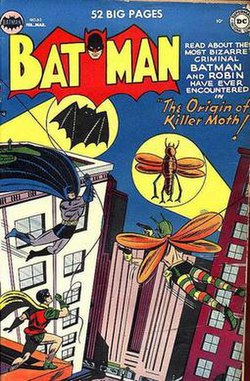An editor has nominated this article for deletion. You are welcome to participate in the deletion discussion , which will decide whether or not to retain it. |
| Killer Moth | |
|---|---|
 Interior artwork from Batman Family #15 (December 1977), art by Michael Golden. | |
| Publication information | |
| Publisher | DC Comics |
| First appearance | (Walker): Batman #63 (February 1951) (Charaxes): Underworld Unleashed #1 (November 1995) (Unknown): Batman #652 (June 2006) |
| Created by | Bill Finger (writer) Dick Sprang (artist) Lew Schwartz (artist) |
| In-story information | |
| Alter ego | Drury Walker Unknown |
| Species | Human (formerly) Metahuman (currently) |
| Team affiliations | (Walker): Secret Society of Super Villains Longbow Hunters |
| Notable aliases | (Walker): Charaxes Cameron van Cleer 234026 The Moth |
| Abilities | (Both):
(As Charaxes):
|
Killer Moth (Drury Walker) is a supervillain appearing in comic books published by DC Comics, usually as an adversary and dedicated original foil personality of Batman (prior to the creations of Wrath, Prometheus, and Hush). Like Batman, he has no superpowers and relies on his technical equipment, including a Mothmobile and numerous gimmicks. Killer Moth originally wore a garish costume of purple and green striped fabric, with an orange cape and moth-like mask. [1] In Underworld Unleashed , Killer Moth is transformed into the monster Charaxes with superhuman abilities.



